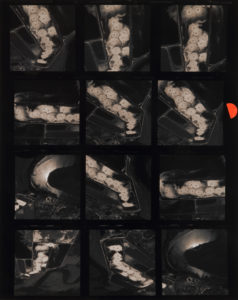Emmet Gowin
American, born 1941; lives in Newtown, Pennsylvania

Emmet Gowin (American, born 1941), Aeration Pond, Toxic Water Treatment, Georgetown, South Carolina (detail), 2001, printed later, pigmented inkjet print, 15 × 15 inches, commissioned with funds from the H. B. and Doris Massey Charitable Trust and Lucinda W. Bunnen, 2004.191.1. © Emmet Gowin.
Since he began making photographs in the 1960s, Emmet Gowin’s interests have oscillated between intimate exploration of familial bonds to urgent explorations of environmental havoc wreaked by human interventions in the natural world. His interest in aerial photography was sparked by a commission to photograph the devastation following the eruption of Mount St. Helens in 1980. Finding it impossible to approach by land, he took to the air and capitalized on the elevated vantage. Characteristic of Gowin’s aerial photographs, which he has made all over the world, is a tension between the root cause of the landscape’s altered appearance and the ways he renders it provocatively beautiful.
When the High awarded Gowin a commission in 2001, he had nearly completed his survey of the earth from above but was drawn back in by the opportunity to incorporate a region he knew so well having grown up in Virginia. Beginning in Savannah, he photographed paper mills across the South, which he described as “plantations of the new South” because they had in many cases replaced earlier rice, cotton, and tobacco plantations. But instead of focusing on the factories themselves, he concentrated on their impact on the land and especially the bodies of water nearby. “I am totally enthralled with the idea that for every action there is a trace, and to unfold the traces was to re-experience, to be reacquainted with the action,” he explained. “Everything which human beings do, every activity, leaves its mark.” In the aeration ponds and streams, toxic chemicals blossomed and bloomed into uncanny, abstract shapes and patterns, altering the land and creating entirely new visions of a world indelibly marked by industry.
Gowin’s commission is exhibited here for the first time. This series was the first that he printed as digital inkjet prints. Though he was excited by the added control digital photography afforded, he was never satisfied with the prints he made at time when digital printing was in its infancy; he remade these prints in 2020 in anticipation of this exhibition.
“Everything which human beings do, every activity, leaves its mark.”
-

Aeration Pond, Toxic Water Treatment Facility, Crossett, Arkansas
Emmet Gowin, American, born 1941
2001, printed later
Pigmented inkjet print
Image/Sight: 15 × 15 inches (38.1 cm × 38.1 cm) Other (paper): 22 × 17 inches (55.9 cm × 43.2 cm)
Commissioned with funds from the H. B. and Doris Massey Charitable Trust and Lucinda W. Bunnen
2004.195.1 -

Effluent From the Ashdown Paper Mill Entering the Red River, Arkansas
Emmet Gowin, American, born 1941
2001, printed later
Pigmented inkjet print
Image/Sight: 15 × 15 inches (38.1 cm × 38.1 cm) Other (paper): 22 × 17 inches (55.9 cm × 43.2 cm)
Commissioned with funds from the H. B. and Doris Massey Charitable Trust and Lucinda W. Bunnen
2004.199.1 -

Aeration Pond, Toxic Water Treatment Facility, St. Mary’s, Georgia
Emmet Gowin, American, born 1941
2001, printed later
Pigmented inkjet print
Image/Sight: 15 × 15 inches (38.1 cm × 38.1 cm) Other (paper): 22 × 17 inches (55.9 cm × 43.2 cm)
Commissioned with funds from the H. B. and Doris Massey Charitable Trust and Lucinda W. Bunnen
2004.201.1











